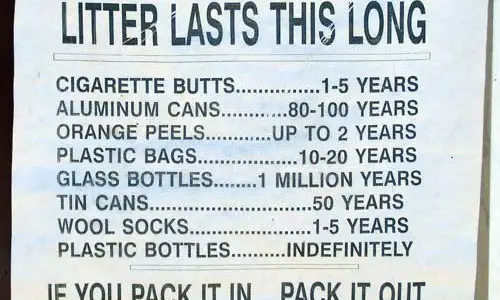1. Putting trash in wrong places
Simply put, littering means putting trash in places where it is not supposed to be put. Trash may belong to various places namely recycling bin, garbage can, sanitary landfill, reuse facility or a waste-to-energy plant. Places where trash does not belong include rivers, air, rivers and the ground.
2. Paper Waste
25% of paper products in the world are used in the US. Each day, the US cuts 2 million trees and trashed approximately 42 million newspapers, an equivalence of half a million trees each week. Each year, 85 million tons of paper are used in US, this about 680 pounds of paper per person. Each day, businesses in the US use papers that are enough to go round the earth 20 times.
3. Main sources of Litter
Generally, litter originates from 7 main sources. Four of these sources are stationary and include places where people work and live such as collection points for business trash, household trash, industrial and business loading docks as well as demolition and construction sites. The other three trash sources are moving sources and include pedestrians, motorists and uncovered trucks.
4. Quantity of Litter
On average, each American generates litter that is 600 times their adult weight in a lifetime. It is estimated that an average baby produces one ton of litter each year. Americans dispose an estimated 21 million bags of food in landfills each year. In the U.S., ne out of six trucks transports garbage.
5. Littering creates Ugly Scenes
Littering causes a place to look ugly and is associated with high crime rates, reduced pride in littered neighborhoods and low property value. Litter tends to attract more litter resulting to formation of a dumpsite. The best way to prevent accumulation of litter in an area is to ensure that dropped litter is collected soonest possible.
6. Littering is Costly
Though people often agree that litter is ugly, many do not associate it with the economic, environmental and legal repercussions it brings about. For instance, millions of dollars are spent cleaning up litter in most states within the U.S. Houses that are placed on sale within littered areas do not fetch good prices and owners end up losing money. Fires ignited by dumped or dropped litter result to damages worth millions of dollars each year.
7. Littering is Illegal
Littering is illegal and attracts fines in most states. In Pennsylvania State, persons found littering from vehicles are fined a maximum of 300 dollars. Most places have fines for pedestrians and businesses that are found littering. Persons who open packages and drop wrappers on sidewalks engage in illegal acts that can result to charges because littering is illegal.
8. Littering degrades Natural Areas and harms Plants and Animals
Litter is capable of stunting the growth of plants or killing them altogether. Most people do not consider the harm that litter causes natural areas. Numerous tiny animals crawl into jars or bottles where they get stuck and starve to death. Animals tend to get stuck in plastic bags, pack rings and fishing lines, birds get trapped and are unable to flee from danger. Each year, there are millions of animals, fish and birds that die due to littering.
9. Litter from Beverage
An average family in the use consumes about 104 gallons of milk, 182 of soda, 29 of juice and 26 of bottled water each year. Americans dispose of 25 billion Styrofoam cups each year, enough to go round the earth 436 times. Each hour, 2.5 million plastic bottles are used every hour.
10. Littering problem is Controllable
Littering is a problem that is possible to control. Educating the public about the danger of littering is an effective way of addressing the problem. Persons who are ware of dangers caused by littering tend to make the effort to place trash in the right places. Cleanups organized within communities help in encouraging people to be proud of their neighborhoods.









Leave a Reply